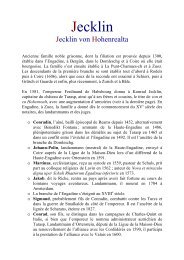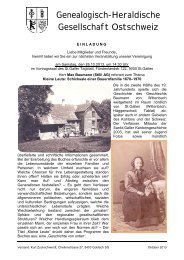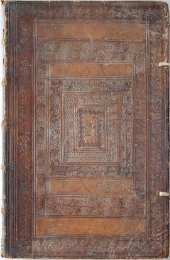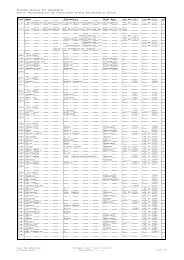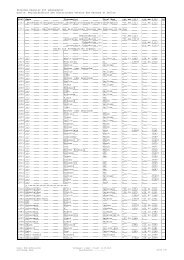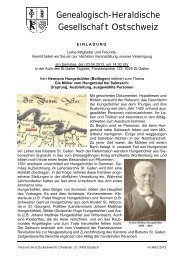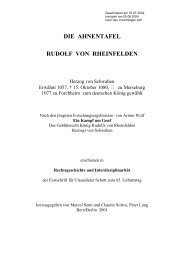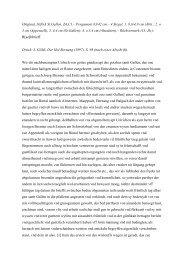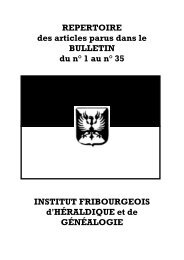The History of the Glarus Families, especially Those of the Sernf ...
The History of the Glarus Families, especially Those of the Sernf ...
The History of the Glarus Families, especially Those of the Sernf ...
Create successful ePaper yourself
Turn your PDF publications into a flip-book with our unique Google optimized e-Paper software.
assistance; for that reason <strong>the</strong>y had to enter into relations with <strong>the</strong>ir friends in Zürich and, <strong>the</strong>refore, also <strong>the</strong> ones<br />
in Canton Schwyz, those from Arth and <strong>the</strong> cantons <strong>of</strong> <strong>the</strong> Old Confederation.<br />
c <strong>The</strong> Stoss is a measure <strong>of</strong> how many livestock are allowed to graze on a given piece <strong>of</strong> land. One Stoss = 1 cow<br />
or steer, or 3 calves, or 5 sheep or goats, for example. [SW]<br />
9 At that time - in 1416 - <strong>the</strong> number <strong>of</strong> animals was fixed at 545½ Stoss. In 1714 it amounted to only 436<br />
Stösse, according to J.H. Tschudi (Chronicles, page 927)<br />
10 Archives I, page 531f.<br />
11 Rüti, Zürich.<br />
12 Old urban district <strong>of</strong> Zürich.<br />
d <strong>The</strong> Popular Assembly, which is <strong>the</strong> cantonal legislative body in <strong>Glarus</strong> and several o<strong>the</strong>r cantons. It is made<br />
up <strong>of</strong> all <strong>the</strong> citizens <strong>of</strong> <strong>the</strong> communes who have full citizenship rights. [SW]<br />
13 Bal. Tschudi, see Historical Yearbook, Number 24, page 14.<br />
14 "Disclaimer and Letter <strong>of</strong> Pardon <strong>of</strong> <strong>Those</strong> from Werdenberg" <strong>of</strong> 29 Nov 1525. <strong>The</strong>re <strong>the</strong>y admitted: "That<br />
<strong>the</strong>y persisted in such misdeed and error, which was regarded as irrationally and pettily reasonable, until eventually<br />
we were aware <strong>of</strong> and realized our arrogant and unjust actions, and so we have agreed to our natural masters<br />
that we are <strong>of</strong> your own people, and have also confessed to ourselves our injustices and errors against <strong>the</strong> aforesaid,<br />
our merciful masters <strong>of</strong> <strong>Glarus</strong>, and surrender to our punishment and disgrace freely and submissively."<br />
(Historical Yearbook, 24, page 187).<br />
15 According to one still existing old fragment (letter <strong>of</strong> indulgence), Joh. Speich also belonged to Zwingli's circle<br />
<strong>of</strong> acquaintances (Em. Egli, Analecta Reformatoria I, page 13).<br />
16 Document Book I, page 107.<br />
17 <strong>The</strong> Speichs came to Engi by means <strong>of</strong> Tagwen Official, Church Steward and Councillor Jakob Speich (ma rried<br />
in 1630, died in 1687 - "who departed <strong>the</strong> Schwanden Landsgemeinde on 27 April 1687 for Mitlödi, where<br />
he died without a particular illness and was buried in Schwanden"). Today, and for a long time already, <strong>the</strong>y<br />
have again become extinct in Engi.<br />
18 Of <strong>the</strong> 10 Speich families which <strong>the</strong> church book for <strong>the</strong> period <strong>of</strong> 1595-1613 acquaints us with, 5 became<br />
entirely extinct, according to information from Teacher D. Bäbler.<br />
19 <strong>The</strong> Matt death book reports: "On 1 February 1616 was buried Joss Speich, whom his bro<strong>the</strong>r, Läri, had<br />
stabbed to death, so that he continued in his stead."<br />
20 Below <strong>the</strong>se an Abraham is also found, which suggests <strong>the</strong> conjecture that <strong>the</strong> above-mentioned Franz and<br />
Abraham had been bro<strong>the</strong>rs.<br />
21 About individual Speichs from Luchsingen, see <strong>the</strong> Historical Yearbook, number 26, page 27 ff.<br />
22 <strong>The</strong>y were Catholics, and <strong>the</strong> tradition is said to exist that <strong>the</strong>y had emigrated <strong>the</strong>re at <strong>the</strong> time <strong>of</strong> <strong>the</strong> Refo rmation.<br />
Possibly, that a <strong>Sernf</strong> valley Speich, who was <strong>of</strong> <strong>the</strong> old faith, held fast to <strong>the</strong> Mass and <strong>the</strong> images and<br />
didn’t enjoyed it any more in <strong>the</strong> <strong>Sernf</strong> valley, as his fellow-citizens removed images and altars so ruthlessly.



